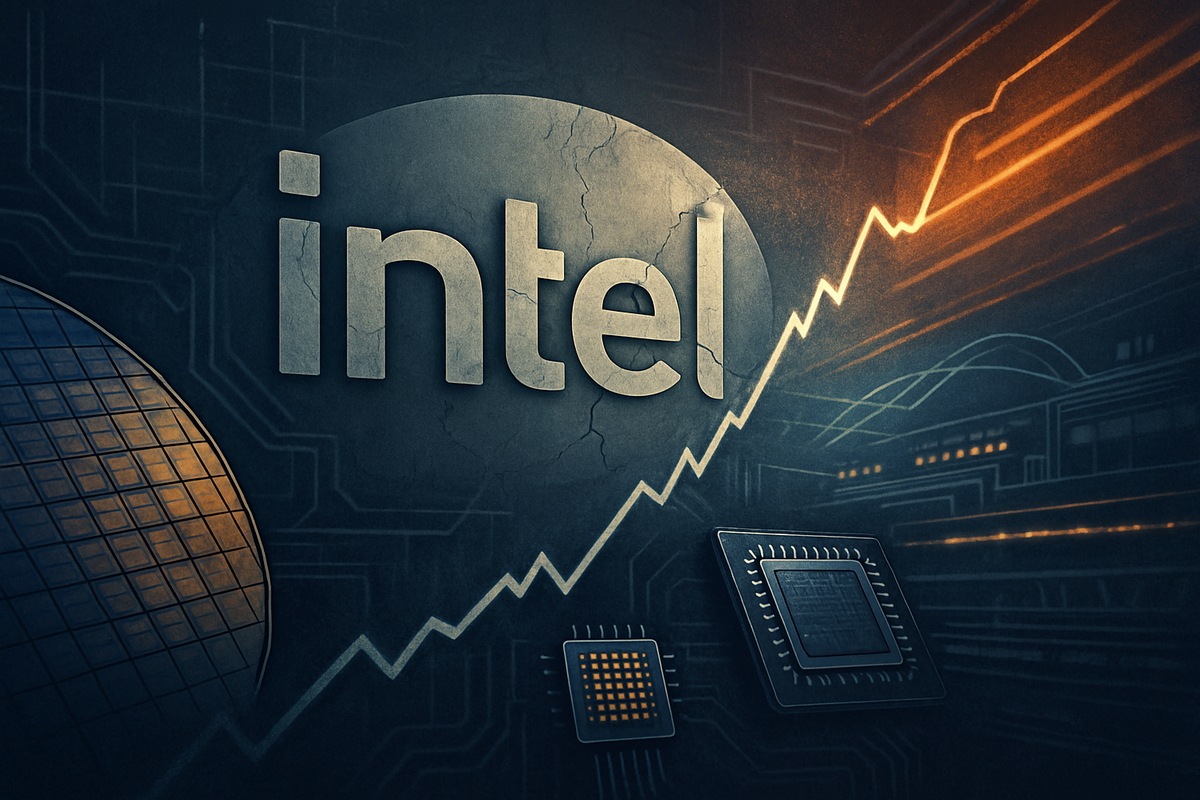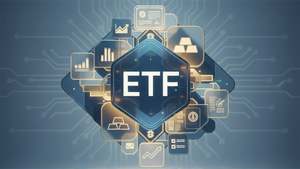
Intel (NASDAQ: INTC), once an undisputed titan of the semiconductor industry, finds its valuation under intense scrutiny as of October 2025. Despite a significant surge in its stock price over the past year, the company continues to grapple with fundamental challenges, including persistent unprofitability, manufacturing hurdles, and an intensely competitive landscape. This dichotomy presents a complex picture for investors: a market seemingly optimistic about Intel's ambitious turnaround plan, yet one that is heavily discounting current financial performance in favor of speculative future success.
The immediate implication of Intel's stretched valuation is a heightened level of expectation placed upon its leadership. With a negative trailing twelve months (TTM) P/E ratio indicating current losses and a forward P/E ratio exceeding 56.5x, the market is pricing in a dramatic recovery in earnings. This optimism is fueled by strategic initiatives like IDM 2.0 and potential foundry deals, but it also means that any misstep or delay in execution could lead to significant investor disappointment and downward pressure on the stock. The company's ability to navigate its complex manufacturing roadmap, attract and retain foundry customers, and innovate in crucial growth areas like AI will be paramount in justifying its current market capitalization, which hovers around $159 billion to $177 billion.
Intel's Ambitious Turnaround Faces Formidable Obstacles
Intel's journey over the past few years has been characterized by a determined, albeit arduous, effort to reclaim its technological leadership and manufacturing prowess. Under CEO Pat Gelsinger, the company launched its IDM 2.0 strategy, a multi-faceted plan aimed at re-establishing process leadership, building out a robust foundry business (Intel Foundry Services or IFS), and continuing to innovate in its core product segments. However, this ambitious pivot has been fraught with challenges.
Specific details reveal a difficult path. In the second quarter of 2025, Intel reported revenue of $12.9 billion, flat year-over-year, but still posted a GAAP earnings per share (EPS) loss of $(0.67) and a non-GAAP EPS loss of $(0.10). A significant drag on profitability was the substantial decline in gross margin to 29.7%, partly due to $800 million in non-cash impairment and accelerated depreciation charges related to excess tools. The IFS segment, a cornerstone of the IDM 2.0 strategy, saw its operating margin plummet to a staggering -72% in Q2 2025. A critical timeline event is the scheduled Q3 2025 earnings report on October 23, 2025, which will provide further insight into the success of these initiatives. Adding to the concerns are reports of significant quality challenges with Intel's crucial 18A manufacturing process, intended to be a cornerstone of its technological comeback. Initial testing of 'Panther Lake' chips, slated to use this process, reportedly showed defect densities exceeding industry norms, potentially delaying production timelines and hindering efforts to compete with the likes of Taiwan Semiconductor Manufacturing Company (NYSE: TSM). Key players involved include Intel's leadership, led by Pat Gelsinger, and formidable competitors such as Advanced Micro Devices (NASDAQ: AMD), NVIDIA (NASDAQ: NVDA), and TSMC. Initial market reactions have been mixed; while the stock has seen a significant rally, driven by speculative optimism and potential foundry deals, many analysts remain cautious, with some downgrading the stock due to persistent competitive challenges and the already priced-in nature of potential improvements.
Intel's struggles are also underscored by its ongoing market share erosion, particularly in the booming artificial intelligence (AI) chip market and server CPUs. The company's past missed opportunities in mobile and Extreme Ultraviolet (EUV) lithography have allowed competitors, particularly TSMC, to build a significant technological advantage. This has led to major players like Apple (NASDAQ: AAPL), NVIDIA (NASDAQ: NVDA), and AMD (NASDAQ: AMD) predominantly rely on TSMC for their leading-edge chip production. In response to these pressures, Intel has initiated aggressive cost-cutting measures, including plans to reduce its core workforce by approximately 15% (targeting 75,000 employees by the end of 2025), consolidate assembly and test operations, and cancel or slow down new factory projects in Germany, Poland, and Ohio, leading to $1.9 billion in restructuring charges in Q2 2025. The company's lack of a clearly defined AI strategy further exacerbates its competitive challenge in a rapidly evolving market.
Shifting Fortunes: Who Wins and Loses in Intel's Reconfiguration
Intel's (NASDAQ: INTC) ongoing struggles and ambitious strategic pivot have sent ripple effects across the semiconductor ecosystem, creating clear beneficiaries and posing complex challenges for others. The competitive landscape is intensely dynamic, with rivals capitalizing on Intel's manufacturing woes and market share erosion.
Among the clearest winners is Advanced Micro Devices (NASDAQ: AMD), which has relentlessly gained ground in both the PC and server CPU markets. AMD's consistent reliance on Taiwan Semiconductor Manufacturing Company's (NYSE: TSM) advanced process technologies has provided a significant technological edge, allowing it to offer highly competitive products that directly challenge Intel's traditional dominance. Similarly, NVIDIA (NASDAQ: NVDA) has cemented its position as an undisputed leader in the burgeoning AI chip market, with its GPUs becoming the de facto standard for AI accelerators. While NVIDIA recently invested $5 billion in Intel to co-develop data-center and personal-computing CPUs, its core AI and GPU dominance remains untouched by Intel's challenges, representing a major win for the company. Arm Holdings (NASDAQ: ARM) is another significant beneficiary, particularly with Apple's (NASDAQ: AAPL) successful transition to custom Arm-based silicon for its Macs and the architecture's increasing prevalence in servers and mobile devices. This trend further erodes Intel's x86 stronghold in new and critical markets. TSMC (NYSE: TSM), as the world's leading contract chip manufacturer, also continues to benefit immensely. Intel's own manufacturing difficulties mean increased orders for TSMC from Intel's competitors, and even from Intel itself, as it increasingly relies on external foundries for components of its own products.
Conversely, Intel's challenges present a mixed bag for its partners and customers. While companies like Dell (NYSE: DELL), HP (NYSE: HPQ), and Lenovo (HKEX: 0992), as major PC OEMs, benefit from increased competition between Intel and AMD, leading to potentially better pricing and more diversified supply options, they also face potential instability if Intel's turnaround falters. The instability observed with Intel's 13th and 14th-generation processors in 2024 might push OEMs to explore AMD or even custom Arm solutions more aggressively. Cloud providers such as Microsoft Azure (NASDAQ: MSFT), Amazon AWS (NASDAQ: AMZN), and Google Cloud (NASDAQ: GOOGL), who are increasingly developing custom silicon, are also winners as Intel's struggles in AI push them towards NVIDIA and Arm-based solutions. However, the success of Intel Foundry Services (IFS) could eventually offer them a new foundry option for their custom chip designs, promoting supply chain resilience. For companies heavily reliant on Intel's traditional x86 server CPU offerings, continued instability or declining performance could disrupt their product roadmaps. Furthermore, Intel's decision to scale back large-scale fab projects in Germany and Poland represents a significant blow to Europe's broader semiconductor ambitions, impacting the region's goals for chip independence and job creation.
Wider Significance: A Crucible Moment for the Semiconductor Industry
Intel's (NASDAQ: INTC) current predicament is not merely an isolated corporate struggle; it represents a crucible moment with wider significance for the entire semiconductor industry. The challenges faced by a company that once defined chip manufacturing underscore several broader industry trends, including the escalating costs of advanced chipmaking, the growing importance of foundry services, and the relentless pace of innovation driven by artificial intelligence (AI) and diverse computing architectures.
This event fits squarely into the broader trend of increasing specialization and capital intensity within semiconductor manufacturing. Intel's struggles with its 18A process, and the sheer capital required for its IDM 2.0 strategy, highlight the immense financial and technological hurdles involved in staying at the bleeding edge. This environment favors pure-play foundries like Taiwan Semiconductor Manufacturing Company (NYSE: TSM), which can focus solely on manufacturing excellence for a wide array of customers, thus distributing the immense R&D and capital expenditure burden. The potential ripple effects are substantial: if Intel fails to regain process leadership, it could solidify the dominance of TSMC and further empower fabless designers like NVIDIA (NASDAQ: NVDA) and Advanced Micro Devices (NASDAQ: AMD), who can leverage the best available manufacturing without the overhead. This could also accelerate the shift towards modular chip designs and advanced packaging, where components from various foundries are integrated, demanding greater interoperability and standardization across the industry. Regulatory bodies, particularly in the US and Europe, are keenly watching Intel's progress. The US CHIPS Act and similar European initiatives are designed to bolster domestic semiconductor manufacturing, and Intel is a key recipient of these incentives. Any significant setbacks for Intel could raise questions about the effectiveness of these policies and potentially lead to re-evaluations or increased support for other domestic players or alternative strategies. Historically, this situation draws parallels to past shifts in technology leadership, such as IBM's (NYSE: IBM) transition from hardware to services, or the rise of Microsoft (NASDAQ: MSFT) and Intel in the PC era. The difference here is the sheer foundational nature of semiconductors, making Intel's turnaround critical not just for its own sake, but for national technological competitiveness.
The shift towards diverse computing architectures, particularly the rise of Arm Holdings (NASDAQ: ARM)-based designs, further complicates Intel's path. While Intel's x86 architecture has been dominant for decades, Arm's power efficiency and scalability are increasingly attractive for everything from mobile devices to data centers and custom silicon. Intel's delayed entry and unclear strategy in the AI market, dominated by NVIDIA's GPUs, signifies a critical misstep in a technology that is reshaping computing. This has led to a scramble by Intel to catch up, evident in their partnerships and product roadmaps, but the gap remains significant. The industry is moving towards a future where specialized chips, often designed in-house by tech giants or by nimble fabless companies, are manufactured by a few leading foundries. Intel's attempt to become both a leading designer and a leading foundry (IDM 2.0) is a high-stakes gamble against this backdrop, requiring flawless execution to overcome years of lost ground and re-establish trust with potential foundry customers like Qualcomm (NASDAQ: QCOM), who have previously cited concerns over Intel's quality and reliability. The outcome of Intel's efforts will dictate not just its own future, but also the balance of power and innovation within the global semiconductor supply chain for decades to come.
What Comes Next: A High-Stakes Bet on Execution and Innovation
Intel's (NASDAQ: INTC) future hinges on the successful execution of its ambitious IDM 2.0 strategy, a multi-year blueprint designed to reclaim process leadership and establish a robust foundry business. As of October 2025, the company is deeply entrenched in a critical phase of this transformation, facing both immense opportunities and formidable challenges.
In the short-term (2025-2026), Intel's immediate focus is on delivering its "five-nodes-in-four-years" promise, with the critical 18A process technology ramping up. Chips like "Panther Lake" for PCs and "Clearwater Forest" for servers are slated for high-volume production and shipment in late 2025 and early 2026, respectively. A significant push is also on to ship 100 million "AI PCs" by the end of 2025, integrating AI capabilities directly into its core client business. Under the leadership of new CEO Lip-Bu Tan, who took the helm in March 2025, the company is prioritizing an "engineering-first culture" alongside aggressive cost-cutting measures, targeting $10 billion in savings through workforce reductions of 15-20% by 2025. Long-term (2026-2030 and beyond), Intel's vision is to solidify its leadership by introducing nodes beyond 18A, such as 14A by 2027, and to become the world's second-largest foundry by 2030. This requires continuous heavy investment in R&D and a successful diversification of revenue streams beyond traditional PC sales.
Market opportunities are significant, particularly in the burgeoning AI and data center sectors. Intel's Gaudi 3 AI accelerator chips, launched in 2024, aim to compete in the AI market, while its "AI PC" initiative taps into a market projected to grow significantly. The demand for diversified chip manufacturing, driven by geopolitical tensions, also presents a substantial opportunity for Intel Foundry Services (IFS), especially with government backing through initiatives like the U.S. CHIPS Act, which has allocated substantial funding to Intel. Strategic partnerships, notably a landmark design win with Microsoft (NASDAQ: MSFT) for its 18A process and NVIDIA's (NASDAQ: NVDA) $5 billion investment and manufacturing collaboration, underscore the potential. However, the path is fraught with challenges, including intense competition from Advanced Micro Devices (NASDAQ: AMD) and NVIDIA, persistent financial pressures from high capital expenditures and negative free cash flow, and execution risks within the foundry business. Analysts continue to highlight concerns about Intel's AI strategy, noting a lag in GPU and overall AI performance compared to rivals.
Three potential scenarios emerge for Intel's future. A bullish scenario envisions Intel successfully executing its 18A and 14A roadmap, securing major contracts from hyperscalers, and re-establishing manufacturing dominance, leading to a significant re-rating of its valuation. A base/moderate scenario sees government funding continue, but with some delays, and Intel achieving steady, albeit moderate, growth driven by AI demand and its foundry efforts. In this outcome, the stock shows mixed performance, with revenue growing steadily. The bearish scenario entails continued market share losses, failure to secure major 14A customers leading to the potential discontinuation of advanced manufacturing operations, and ongoing struggles with profitability and debt. In this dire outcome, the stock could see significant declines. Intel's strategic pivots, particularly IDM 2.0 and the success of IFS with its 18A process, utilizing innovations like RibbonFET and PowerVia, are the linchpins for its long-term viability. The company's ability to navigate these complex technological and financial hurdles will ultimately determine its standing in the future of the semiconductor industry.
Wrap-up: A Defining Moment for a Semiconductor Giant
Intel's (NASDAQ: INTC) current journey represents a defining moment for a company that has long been synonymous with technological innovation. As of October 2025, the semiconductor giant is caught between a market that is betting heavily on its future potential, reflected in a "stretched" valuation despite current unprofitability, and the harsh realities of intense competition, manufacturing complexities, and significant financial outlays required for its ambitious turnaround. The key takeaway is that Intel is undergoing a fundamental transformation, attempting to pivot from an integrated device manufacturer primarily focused on its own products to a hybrid model that also serves as a world-class foundry.
Moving forward, the market will closely scrutinize Intel's execution on several fronts. Investors should watch for concrete signs of progress in the ramp-up of its 18A process technology and the subsequent 14A node. Securing additional high-profile foundry customers beyond Microsoft (NASDAQ: MSFT) and the collaboration with NVIDIA (NASDAQ: NVDA) will be crucial for validating the Intel Foundry Services (IFS) business model and achieving its goal of profitability by 2027. Furthermore, Intel's ability to articulate and deliver a compelling and competitive artificial intelligence (AI) strategy, particularly in the face of NVIDIA's (NASDAQ: NVDA) dominance and Advanced Micro Devices' (NASDAQ: AMD) advancements, will be paramount. The financial metrics, especially gross margins, operating margins, and free cash flow, will serve as critical indicators of whether the significant capital investments are translating into sustainable profitability.
In conclusion, Intel is navigating a high-stakes gamble that could either re-establish its technological leadership and market relevance or lead to further erosion of its market position. The lasting impact of this period will not only shape Intel's destiny but also influence the broader semiconductor landscape, potentially reinforcing the trend towards specialized foundries and diverse computing architectures. For investors, the coming months will offer vital clues as to whether Intel can truly deliver on the immense expectations currently priced into its stock, making it a story of intense interest and significant implications for the global technology sector.
This content is intended for informational purposes only and is not financial advice

















